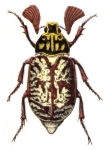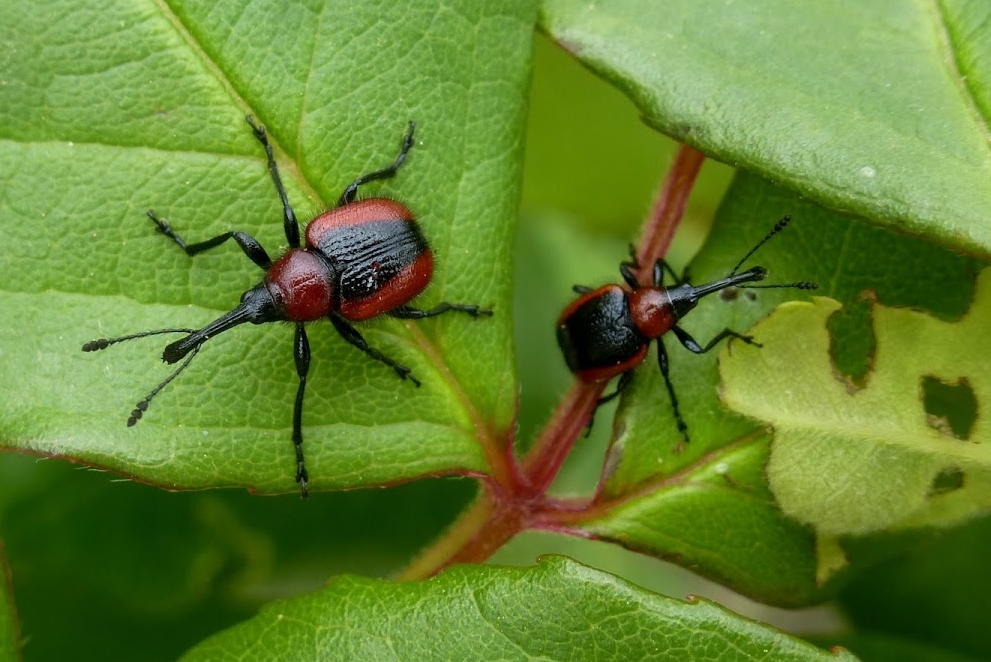|
Description / Habitats / Flora / Vertebrates / Insects / Invertebrates / What's that Bug? Home / Nestos Delta / Bibliography / About this site / Links / Contents / Galleries ____________________________________________________________________________ |
|
__________________________________________________________________________________________________________ THE PRIMITIVE WEEVILS (COL., RHYNCHITIDAE, APIONIDAE & NANOPHYIDAE) OF THÁSOS
Mecorhis ungarica (c) Stavros Apostolou Weevils are beetles in the Superfamily Curculionoidea, one of the most speciose animal groups on Earth with over 90,000 species recognised so far and estimates suggest that more than 200,000 species are still to be discovered and named. They are (almost) all herbivorous, feeding on leaves, buds, flowers, stems, seeds, fruits, galls, bark, decaying wood, fungi, etc. of the majority of the plant species on Earth. Unravelling this immense diversity to determine evolutionary relationships within taxonomy is ongoing and complex but the primary division is between the Orthoceri and the Gonatoceri, which is distinguished (with a few exceptions) by the angle at which the antennae are held. The Orthocerous weevils hold their antennae straight, without a bend at the 'elbow' of the first segment, the scape. They are regarded as the Primitive Weevils and although recent classifications now consider some of the formerly recognised Families as sub-Families, here the 'traditional' classification employed by Fauna Europaea is utilised, in which the Rhynchitidae, Apionidae and Nanophyidae are represented on Thásos. Each of these taxonomic groups are distinct from each other and readily recognised as 'rhynchitids', 'apionids' or 'nanophyids', but all are small (usually less than 4mm long) and unlikely to be seen unless specifically searched for. Weevils can be found by general collecting methods (sweeping, beating, etc.) but a knowledge of potential hostplants greatly enhances success as most weevils are closely tied to one plant species or a small group of closely related plants species. The Rhynchitidae are mainly associated with trees and shrubs, most Apionidae develop on herbaceous plants, and the Nanophyidae are wetland species occurring on loosestrifes Lythraceae spp. as well as tamarisk Tamarix spp. Little effort has been spent beating as a survey technique on Thásos and this is reflected in the fact that only five Rhynchitidae species have been recorded on the island, whereas Germann et al. (2018) list 34 species as having been recorded in Greece (plus three Attelabidae species). Wetland habitats are very restricted on Thásos and it is not surprising that there are just two Nanophyidae species known from Thásos, out of 15 recorded from Greece. Sweeping in grassland habitats and grubbing amongst low-growing plants are the most productive techniques to find apionids and much of my recording on the island has been done this way. Forty-three of the 149 Apionidae known from Greece have so far been found on Thásos and, whilst more species undoubtedly occur, this is a respectable total for an Aegean island. On Lesbos, Germann & Braunert (2016) report a total of 50 species from the primitive weevil Families, including 36 Apionidae, and on Samos Germann et al. (2015) list 30 Apionidae species amongst the 50 primitive weevil species known from that island. Bayer et al. (2007) record 35 species from the Orthoceri Families, which includes 27 Apionidae, from the southern Aegean island of Rhodos. There do not appear to be any previous published records of orthocerous weevil species from Thásos and it is surprising that Karnozickij (1959) omits them altogether from his paper, even though 15 species from other weevil Families are listed. Presumably it was not possible to identify the material collected by Bulgarian entomologists in the 1940s, but perhaps the specimens are still extant in a museum, as surely they would have taken many apionids in the course of their exhaustive surveys. The online catalogue of Greek weevils maintained by Germann et al. (2018) includes a record of Protapion brenskei from Thásos by K. Schön in 2006 and P.F. Whitehead (pers. comm.) informs me that he collected Diplapion confluens and Holotrichapion pisi from the island in October 1994. I have found each of these three species during my own surveys so that I have personally collected all 50 orthocerous weevil species recorded from Thásos. The majority of species currently known from the island are widespread in Europe. Three species, Squamapion delagrangei, Protapion brenskei and Allomalia sexpunctata, have their European distribution restricted to Greece, although they also occur in neighbouring countries of the Near East. S. delagrangei occurs on mint Mentha sp. in olive groves around Thassos Town and in damp coastal grassland at Skala Potamias, whilst the foodplant of P. brenskei is uncertain although it will be one of the clovers Trifolium sp. and it has been recorded from coastal beaches at Skala Kallirachis and Cap Prinos and up to 950 metres asl on Ipsarion. Stüben (2024), recognising that A. sexpunctata is a separate species from A. quadrivirgata (Costa, 1863), gives the distribution as Greece and the Near East, where it occurs on Tamarisk bushes, as at Skala Maries. There is, unfortunately, no published work covering the identification of Greek weevils and the fauna is incompletely known. Recent research by members of the Curculio Institute (Bayer et al. 2007, Germann et al. 2018) has sought to address this and their online catalogues and keys are an important contribution to our understanding of the rich diversity of the Greek fauna. I should also draw attention to Mark Russell's wonderfully illustrated review of the genus Protapion in the Western Palaearctic (Russell 2004), which includes a key to all described species. I am grateful to Prof. Mike Morris, Mark Russell, Paul Whitehead, Herbert Winkelmann and the late Luigi Magnano for their help with identification. CHECKLIST
Rhynchitidae
Apionidae
REFERENCES
Bayer, C., Winkelmann, H. & Bahr, F. 2007. Ergebnisse einer faunistischen Studie auf der Insel Rhodos. Erster Beitrag zur Fauna von Griechenland (Coleoptera, Curculionoidea). Weevil News, No. 37: 10 pp., CURCULIO-Institute: Mönchengladbach Germann, C. & Braunert, C. 2016. An annotated checklist of the weevils of Lesbos Island, Greece (Coleoptera, Curculionoidea). Parnassian Archives, 4: 3-17. Germann, C., Braunert, C., Link, A. & Ockermüller, E. 2018. Die Rüsselkäfer Griechenlands: Katalog der Curculionoidea Griechenlands (Coleoptera). Le Charançon, 3. [http://curci-gr.site.at/; retrieved 27 July 2018] Germann, C., Müller, G., Müller, U. & Schön, K. 2015. An annotated checklist of the weevil fauna of Samos Island with new records for Greece (Coleoptera, Curculionoidea). Contributions to Natural History, 27: 1-26. Karnozickij, N. 1959. Materialien zur Koleopteren-Fauna der Agäischen Küste und Insel Thasos. Izv. zool. Inst. Sof., 8: 237-253. Russell, M. 2004. Apionidae of the Western Palaearctic: Volume 2 Piezotrachelini (l); Protapion Schilsky, 1908. Peterborough, Crocodile Press. Stüben, P.E. 2024. Allomalia sexpunctata (Kiesenwetter, 1864) resyn. (Coleoptera: Curculionoidea: Nanophyinae) – Haben lange Synonymielisten eine Zukunft? Entomologie heute, 34: 87-99.
|

















